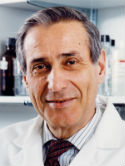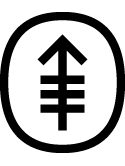Improved survival of poor prognosis diffuse histiocytic (large cell) lymphoma managed with sequential induction chemotherapy, "boost" radiation therapy, and autologous bone marrow transplantation Journal Article
| Authors: | Chadha, M.; Shank, B.; Fuks, Z.; Clarkson, B. D.; Bonfiglio, P.; Gnecco, C.; Gulati, S. |
| Article Title: | Improved survival of poor prognosis diffuse histiocytic (large cell) lymphoma managed with sequential induction chemotherapy, "boost" radiation therapy, and autologous bone marrow transplantation |
| Abstract: | From 1981 to 1985,33 patients with the diagnosis of diffuse histiocytic (large cell) lymphoma (DHL) with a poor prognosis received induction multi-drug chemotherapy followed by autologous marrow cryopreservation. Thirty patients who had residual disease after chemotherapy were given "boost" irradiation to these sites, followed immediately by hyperfractionated total body irradiation, 1320 to 1375 cGy in I1 fractions over 4 days, then cyclophosphamide (60 mg/kg/d) for 2 days. All patients received an autologous bone marrow transplant (ABMT), with 15 patients receiving marrow purged with 4-hydroperoxycyclophosphamide. Patients were transplanted either as part of a planned induction-transplant approach (Group I), or as salvage after relapse on the same induction regimen (Group II), or other conventional chemotherapy regimens (Group III). In the entire group, 16 of 33 patients (48%) are alive free of lymphoma with a median follow-up of 32 months (11 to 53 mo). Actuarial (Kaplan-Meier) survival is 51% at 2 years and 46% at 3 years, with only 1 patient dying after 2 years out of 11 at risk. Eight patients (24%) succumbed to early treatment related complications. Nine patients (27%) died from relapse. Patients receiving ABMT as planned sequential therapy post-induction (Group I) did significantly better than patients given ABMT as salvage therapy after relapse on prior chemotherapy (Groups II and III) and better than the historical group of patients treated with chemotherapy alone. At 2 years, the survival in Group I is 79% versus 0% for Group II versus 48% for Group III. Historically, this group of high risk patients had a 2-year disease-free survival of 20% or less with chemotherapy alone. © 1988. |
| Keywords: | adolescent; adult; cancer chemotherapy; clinical article; survival rate; prednisone; doxorubicin; combined modality therapy; methotrexate; antineoplastic combined chemotherapy protocols; radiotherapy; cyclophosphamide; vincristine; nonhodgkin lymphoma; non-hodgkin's lymphoma; daunorubicin; bone marrow transplantation; transplantation, autologous; tioguanine; intravenous drug administration; whole-body irradiation; total body irradiation; 4 hydroxycyclophosphamide; histiocytic lymphoma; lymphoma, large-cell; prognosis; human; male; female; priority journal; intrathecal drug administration; autologous bone marrow transplant; diffuse histiocytic lymphoma |
| Journal Title: | International Journal of Radiation Oncology, Biology, Physics |
| Volume: | 14 |
| Issue: | 3 |
| ISSN: | 0360-3016 |
| Publisher: | Elsevier Inc. |
| Date Published: | 1988-03-01 |
| Start Page: | 407 |
| End Page: | 415 |
| Language: | English |
| DOI: | 10.1016/0360-3016(88)90253-2 |
| PUBMED: | 3277931 |
| PROVIDER: | scopus |
| DOI/URL: | |
| Notes: | Article -- Source: Scopus |
Altmetric
Citation Impact
BMJ Impact Analytics
Related MSK Work






